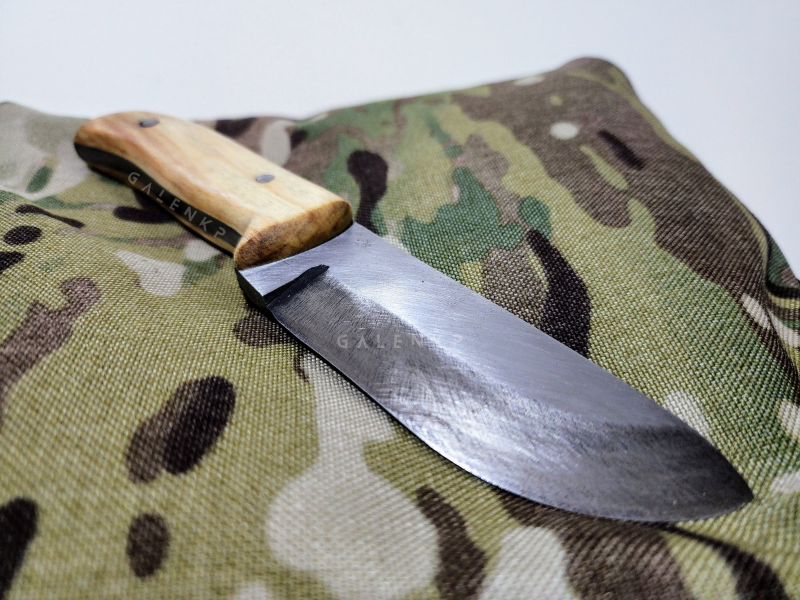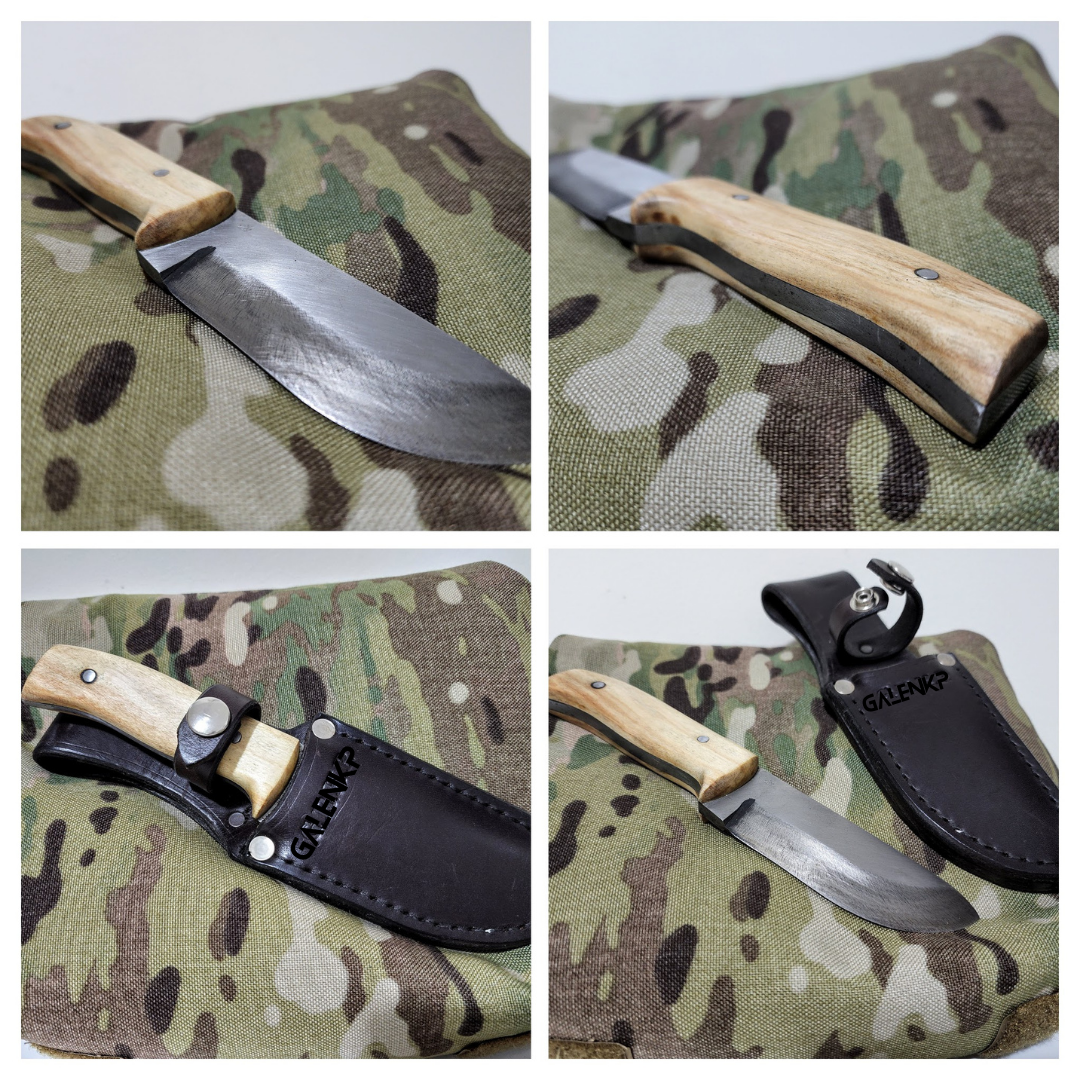A word or two on knives
hive-139358·@galenkp·
0.000 HBDA word or two on knives
<div class="text-justify"> <center></center> It's interesting to think about what life might be like without cutting tools - think about it for a moment...just a little longer and...now come back. What did you decide? Would life be difficult without cutting tools do you think? *I certainly think so!* I thought I'd write a little about knives and more specifically knives for use in the outdoors, hunting, camping, hiking and general survival. Please keep in mind, this is a massive topic that is not easily covered in one small post so I'll be very generic, will leave a lot out and will not get technical. *** #### Grinds and Bevels I don't want to spend much time here but in a nutshell, there's four basic knife grinds including: Conventional, Concave, Convex and Scandi and each has a bevel and some a secondary bevel - This relates to the tip of the knife folks. There are others, but these four are the basic types. - About half of all knives you'll see are *conventional grind*, popular as they offer a balance between sharpness and strength - A good multi-purpose option. - *Concave grind* knives are great for skinning and dressing game, they can be made super-sharp, although they are not as strong as conventional grind knives. Interestingly, the medical profession uses hollow grind knives/blades, primarily for their sharpness of course. - The *convex grind* blade is a very robust knife used for chopping duties, an example is machetes, although they're not exclusively convex grind blades. - The *Scandi grind* (Scandinavian grind) is tapered, without a secondary bevel, and is used for various things including in wilderness, outdoor and survival situations. Their edge retention is high and they are strong enough to suit varied use including skinning and cutting. But enough about grinds and bevels. <center></center> #### The metal It's important to choose the right material for the knife and purpose of use - Not every blade will suit every situation. Stainless steel is great for situations where rust might be an issue such as very wet or marine environments and will hold an edge well. Carbon steel will loose it's edge more rapidly but is easier to re-sharpen. For general survival knives I also like the fact a carbon steel knife can be used to create sparks for fire-making when impacted with flint. #### Blade design Movies have made brutal-looking serrated-edged knives popular but in truth they are something to be avoided in a survival knife in my opinion. They are very difficult to sharpen and are only really of use when cutting rope anyway. I don't like serrations of any kind on my survival/bush knives but carry a Leatherman multitool with serrated blades for when I need one. I think it's best to carry a secondary blade rather than try to get by with a single knife (with serrations)...unless you're Rambo. I also don't like saws on the back of my knives; I find them totally useless. Again, a secondary blade or tool can handle that task and there are many good *folding saws* and multitool options that are compact and robust. Saws are used for notching which can come in very handy, but don't compromise your survival knife for a saw. (That's just my opinion, you can do as you wish.) #### What's the ideal That's not for me to answer and, as stated above, this post is a very simplistic overview of some aspects of knives. I can add some insight though. The choice needs to be determined by where you are and what you may need the knife for. In the tropics a machete may be the most suitable as it's likely slashing-work will be required. In forested areas an axe may be more suited as chopping wood for fires or creating shelter is likely required. I think you get the idea. Oh also, I'm not saying take an axe, and nothing else, into heavily wooded areas, I'm just trying to demonstrate that thought needs to be given to the location and potential use before one choses a knife; this is why I have multiple knives. For me, for general use in the wilderness, I prefer a good quality Scandi grind blade, with full tang of course. You can see my *custom made drop point belt knife* in the images. Oh, *tang*...I forgot to mention that. *Full tang* means the metal of the blade extends from knife-point to the very end of the handle. That's where the strength comes from. You know those *"survival knives"* with med-kits in the handle and a compass on the end? Yeah, *they are shit!* You're better off using your teeth. They are not full tang and are prone to breaking when you need it most. IN my images you can clearly see the *full tang* nature of my drop point. For your belt knife, work around 14 centimetres in blade length (about 5.5 inches) as a maximum. Any longer and it will be cumbersome to wear. It must be full tang, and you'll want a thickness of close to 3.5mm as a minimum...but don't go to thick as weight matters too. I'd suggest carbon steel also. I recommend a belt knife usually but I'm not against *folders*. Such a knife will fit a multitude of uses, be strong enough to take some punishment such as when *batoning* and will, in the right hands make a difference in a survival situation. (Batoning is *splitting wood* basically. Warning, it can be very dangerous, but if done right, and with the right knife, can be safe. This guy shows how to do it in ***<a href="https://www.youtube.com/watch?v=cEvm7IOpLsE ">this YouTube video</a>*** if you're interested. I wanted this drop point knife to be very wearable so I kept the blade quite short at only 11 centimetres (4.33 inches) with an overall length of 21 centimetres (8.2 inches) and it's also quite thick at about 5.5 millimetres (0.21 inches). It's a heavy knife, but I wanted it to be tough so decided for the blade thickness. This thing isn't going to break, there's no doubt about that. It was made by hand of course, with the knife maker in the United States, crafting to my requirements. It didn't come with the leather sheath, I had that made here once the knife arrived. It's all rather sexy to be honest. *** I want to be very clear that this post isn't designed to comprehensively cover everything there is to know about knives...it's not even close. I guess I see it as some basic information that introduces some of the many considerations one must think about when selecting a knife for use in the outdoors, or anywhere really. I guess, similar to the considerations a chef, surgeon or butcher would make when selecting the right knife for the job. I also want to impress upon people that more important than the most expensive knife is *the skills and ability to use it effectively and properly* - Without that knowledge the most expensive knife is worthless. Fell free to comment below, show me one of your own blades or ask any questions. </div> *** Design and create your ideal life, don't live it by default - *Tomorrow isn't promised so be humble and kind* <sub><sub>The images in this post are my own</sub></sub>
👍 liaminit1, hive-142864, papacrusher, alphaccino.art, idea-make-rich, scooter77.pob, joeyarnoldvn, moeenali, therising, jkp.nisha, babytarazkp, tamiapt6, greengalletti, lestrange, soyunasantacruz, janaveda, abh12345, philnewton, tobias-g, misterengagement, mattbrown.art, isabel-vihu, mallorcamum, blockbroccoli, papilloncharity, goingbonkers, rituraz17, aleister, smasssh, cryptoandcoffee, src3, archytas.replica, iamfarhad, simplymike, mike314-0005, organicgardener, oac, noekie, iamthegreat, battlemaster, monsterdoom, mylibrary, flxlove, ltcih, ltcij, ltcil, ityp, zayedsakib, loralgravis, doza, logantron, nyswine, molometer, gawz69, bozz, doomsdaychassis, digital.mine, linco, itmp, jasonbu, fullcoverbetting, pet.society, jongolson, lobaobh, ericburgoyne, cbridges573, delso, themanny, sabinavi, russellstockley, phortun, intrepidphotos, proofofbrain, mytechtrail, petrvl, denmarkguy, royaleagle, onlavu, thanksforplaying, golddeck, pavelsku, gooddeck, velinov86, jelly13, trangbaby, kibela, bigtom13, urtrailer, mjmarquez4151, rafaelgreen, doudoer, belahejna, minismallholding, zemiatin, maajaanaa, babeltrips, pokerarema, dodovietnam, dora381, whynotcamp, crazy-bee, sunnyvo, ivypham, tuyenmei95, sharker, uwelang, teamaustralia, lizelle, simplifylife, jlsplatts, bdmillergallery, foodfightfriday, kuku-splatts, splatts, w-splatts, mjvdc, gone-hive, izzydawn, realtreebivvy, life-relearnt, paulmoon410, blainjones, gloriaolar, labyrinths, tryskele, cosmictriage, notconvinced, cryptoccshow, whitelightxpress, steemitbloggers, jaynie, felt.buzz, roleerob, bettymorgan, abcor, abacam, bet1x2, joker777, artywink, dandays, balikis95, inpursuit, catinthewindow, halukshananah, fog043, pursuant, ctrpch, deadsparrow, becca-mac, azircon, idig, yucevu, trucklife-family, fenngen, astrolabio, binkyprod, allyson19, hubyr, hedidylan, theithei, glstech, tcpaikano, soyrosa, cjsean, raffy, dinglehopper, cabalen, dickturpin, theopinion, badilo, nowserving, darsico, perzeus, rappler, ivet, cristiq, nonameslefttouse, penguinpablo, cryptonized, funnyman, alphacore, piotr42, hungrybear, jacuzzi, tarazkp, jonela, bigmoneyman, bilpcoin.pay, droyvu, drozvu, xplosive, buezor, strawberrry, arasiko, mattclarke, bricksolution, jagged, indiaunited, hardikv, codingdefined, bobinson, sankysanket18, vishire, shonyishere, spydo, frames, vinamra, manojbhatt, rainbowbala, ashley4u, indiaunited-bot, ezunjoshy, khan.dayyanz, badfinger, text2speech, pankajkabdwal, hiteshpandey, okluvmee, sabujdip, disha30, photolovers1, kamaleshwar, chandra.shekar, kannannv, cryptohaytham, attentionneeded, prosocialise, godfather.ftw, punkblogs, olaexcel, qwerrie, hilayvu, sayee, silenteyes, jaimiavu, blind-spot, kellyane, jacobtothe, ksteem, lara88, hive-186141, adedayoolumide, zdigital222, arlin19, krazzytrukker, sagesigma, stayoutoftherz, j85063, soyalex, sportsbuddy, isdarmady, builderofcastles, preparedwombat, insaneworks, aswita, mrchef111, mipiano, cabelindsay, qsounds, cryptofiloz, sparker005, hiveopenmic, iamevilradio, bashadow, ukyron3, trumpikas, kkarenmp, agmoore2, pfunk, vannour, steemcultures, steemworld, creat, mapesa, cisah, pedir-museum, aceh, munzir, sannur, ukulima, anacristinasilva, fengchao, dswigle, nkechi, raphaelle, daveks, artonmysleeve, hivebuzz, lizanomadsoul, manncpt, jnmarteau, globalschool, schmidi, tinyhousecryptos, steemitboard, marivic10, mammasitta, ryivhnn, gorc, pixietrix, shadowlioncub, nyxlabs, yasirgujrati, franzpaulie, tdgodwin3780,